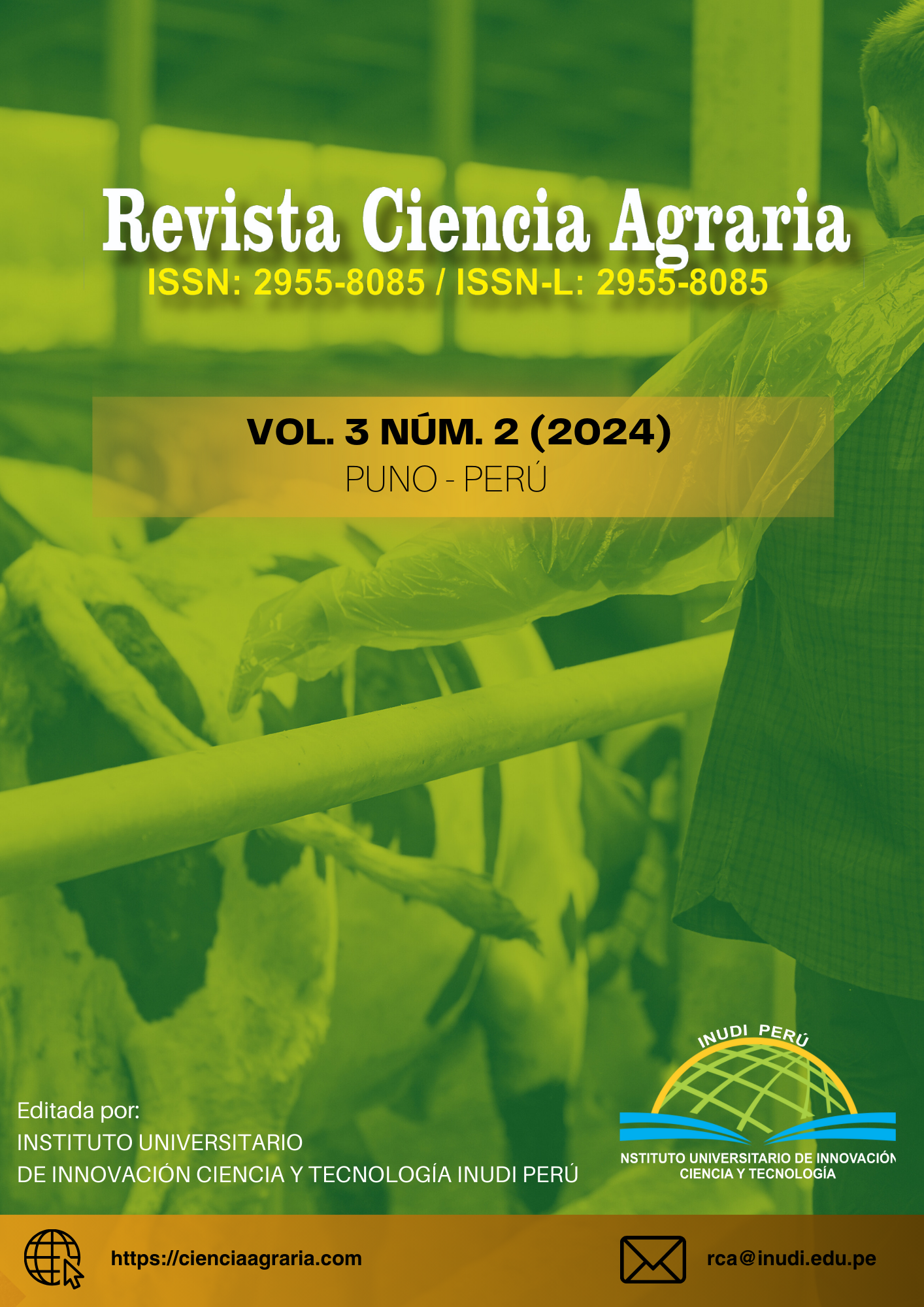Interacciones hematológicas: impacto de las aglutininas vegetales en eritrocitos
DOI:
https://doi.org/10.35622/j.rca.2024.02.002Palabras clave:
agentes bioactivos, aglutininas vegetales, hemaglutinación, lectinas vegetalesResumen
Las lectinas vegetales, especialmente aquellas obtenidas de Phaseolus lunatus, Phaseolus vulgaris y Vicia faba, denotan una importancia crucial en el campo de la medicina debido a su potencial para la identificación de los grupos sanguíneos, ya que estas generan una conjugación entre proteínas de superficie celular. Por lo tanto, establecer métodos de tipificación sanguínea que sean accesibles, económicos y eficaces, son fundamentales en diversas intervenciones médicas como transfusiones y trasplantes. El objetivo fue evaluar la actividad hemaglutinante de las lectinas vegetales en diversos tipos de eritrocitos humanos (A, B, AB, O) con el propósito de identificar patrones de afinidad. Se realizaron pruebas de aglutinación eritrocitaria en 97 muestras biológicas (sangre humana) tratada con EDTA (ácido etilendiaminotetraacético), utilizando un diseño pre-experimental y transversal analítico. Los resultados arrojan diferencias significativas (p = 0,000), esto indica que las lectinas vegetales demuestran un efecto diferente entre ellas, dicho resultado fue corroborado por un análisis Post Hoc; mientras que obteniendo diferencias significativas (p = 0,000) y (p = 1,000), las comparaciones con un valor (p = 1,000) refieren ausencia de diferencias. En conclusión, existen variaciones en el efecto aglutinógeno de las lectinas vegetales, esto sugiere que, si bien algunas lectinas presentan variaciones evidentes, otras podrían carecer de un impacto significativo, lo que posibilita una investigación más minuciosa. Por consiguiente, sería pertinente incorporar estos factores adicionales en el análisis con el fin de adquirir una visión más integral.
Referencias
Al-Thobaiti, S. A., & Konozy, E. H. E. (2022). Purification, Partial Characterization, and Evaluation of the Antiulcer Activity of Calotropis procera Leaf Lectin. Protein and Peptide Letters, 29(9), 775. https://doi.org/10.2174/0929866529666220803162457 DOI: https://doi.org/10.2174/0929866529666220803162457
Barragán, J. A., Zerpa, S. I., Castillo, M. S., Haro, I. R., & Villazón, C. O. (2012). LECTINAS DE Phaseolus vulgarisL. var ñuña “ñuña” y su especificidad hemoaglutinante frente a grupos sanguíneos abo y levaduras. SCIÉNDO, 15(2), 1-8. https://revistas.unitru.edu.pe/index.php/SCIENDO/article/view/485
Booth, P. B., Plaut, G., James, J. D., Ikin, E. W., Moores, P., Sanger, R., & Race, R. R. (1957). Blood chimerism in a pair of twins. British Medical Journal, 1(5033), 1456-1458. https://doi.org/10.1136/bmj.1.5033.1456 DOI: https://doi.org/10.1136/bmj.1.5033.1456
Campos, J. K. L., Araújo, C. S. F., Araújo, T. F. S., Santos, A. F. S., Teixeira, J. A., Lima, V. L. M., & Coelho, L. C. B. B. (2016). Anti-inflammatory and antinociceptive activities of Bauhinia monandra leaf lectin. Biochimie Open, 2, 62-68. https://doi.org/10.1016/j.biopen.2016.03.001 DOI: https://doi.org/10.1016/j.biopen.2016.03.001
Chen, H., Gonzales-Vigil, E., Wilkerson, C. G., & Howe, G. A. (2007). Stability of Plant Defense Proteins in the Gut of Insect Herbivores. Plant Physiology, 143(4), 1954-1967. https://doi.org/10.1104/pp.106.095588 DOI: https://doi.org/10.1104/pp.107.095588
Chen, J., Liu, B., Ji, N., Zhou, J., Bian, H., Li, C., Chen, F., & Bao, J. (2009). A novel sialic acid-specific lectin from Phaseolus coccineus seeds with potent antineoplastic and antifungal activities. Phytomedicine, 16(4), 352-360. https://doi.org/10.1016/j.phymed.2008.07.003 DOI: https://doi.org/10.1016/j.phymed.2008.07.003
Chen, M. S. (2008). Inducible direct plant defense against insect herbivores: A review. Insect Science, 15(2), 101-114. https://doi.org/10.1111/j.1744-7917.2008.00190.x DOI: https://doi.org/10.1111/j.1744-7917.2008.00190.x
Cushnie, T. P. T., Cushnie, B., & Lamb, A. J. (2014). Alkaloids: An overview of their antibacterial, antibiotic-enhancing and antivirulence activities. International Journal of Antimicrobial Agents, 44(5), 377-386. https://doi.org/10.1016/j.ijantimicag.2014.06.001 DOI: https://doi.org/10.1016/j.ijantimicag.2014.06.001
Dang, L., & Van Damme, E. J. M. (2015). Toxic proteins in plants. Phytochemistry, 117, 51-64. https://doi.org/10.1016/j.phytochem.2015.05.020 DOI: https://doi.org/10.1016/j.phytochem.2015.05.020
Djabayan-Djibeyan, P., González-Ramírez, L. C., Ustariz, M. E. L., & Valarezo-García, C. (2022). Aislamiento y actividad biológica de lectinas obtenidas de semillas de frutas, granos y tubérculos de plantas andinas. Información tecnológica, 33(2), 21-36. https://doi.org/10.4067/S0718-07642022000200021 DOI: https://doi.org/10.4067/S0718-07642022000200021
Ghazarian, H., Idoni, B., & Oppenheimer, S. B. (2011). A glycobiology review: Carbohydrates, lectins and implications in cancer therapeutics. Acta Histochemica, 113(3), 236-247. https://doi.org/10.1016/j.acthis.2010.02.004 DOI: https://doi.org/10.1016/j.acthis.2010.02.004
Goldstein, I. J., Hughes, R. C., Monsigny, M., Osawa, T., & Sharon, N. (1980). What should be called a lectin? Nature, 285(5760), 66-66. https://doi.org/10.1038/285066b0 DOI: https://doi.org/10.1038/285066b0
Hamid, R., Masood, A., Wani, I. H., & Rafiq, and S. (2013). Lectins: Proteins with Diverse Applications. Journal of Applied Pharmaceutical Science, 3(4), S93-S103. https://doi.org/10.7324/JAPS.2013.34.S18
Khairiya, F., Dwivany, F. M., Suhandono, S., Hessel, S. S., Zainuddin, I. M., & Tallei, T. E. (2023). In silico Comparative Analysis of Gene and Protein of Plant Lectins. Pertanika Journal of Tropical Agricultural Science, 46(3), 815-838. https://doi.org/10.47836/pjtas.46.3.06 DOI: https://doi.org/10.47836/pjtas.46.3.06
Khan, F., Khan, R. H., Sherwani, A., Mohmood, S., & Azfer, M. A. (2002). Lectins as markers for blood grouping. Medical Science Monitor: International Medical Journal of Experimental and Clinical Research, 8(12), RA293-300. https://doi.org/10.13140/2.1.1744.9606
Konozy, E. H. E., Osman, M. E. M., Dirar, A. I., & Ghartey-Kwansah, G. (2022). Plant lectins: A new antimicrobial frontier. Biomedicine & Pharmacotherapy, 155, 113735. https://doi.org/10.1016/j.biopha.2022.113735 DOI: https://doi.org/10.1016/j.biopha.2022.113735
Kumar, K. K., Chandra, L. P. K., Sumanthi, J., Reddy, S. G., Shekar, C. P., & Reddy, B. V. R. (2012). Biological role of lectins: A review. Journal of Orofacial Sciences, 4(1), 20. https://doi.org/10.4103/0975-8844.99883 DOI: https://doi.org/10.4103/0975-8844.99883
Liyanage, S. H., & Yan, M. (2020). Quantification of binding affinity of glyconanomaterials with lectins. Chemical Communications, 56(88), 13491-13505. https://doi.org/10.1039/D0CC05899H DOI: https://doi.org/10.1039/D0CC05899H
Loris, R., Hamelryck, T., Bouckaert, J., & Wyns, L. (1998). Legume lectin structure. Biochimica et Biophysica Acta (BBA) - Protein Structure and Molecular Enzymology, 1383(1), 9-36. https://doi.org/10.1016/S0167-4838(97)00182-9 DOI: https://doi.org/10.1016/S0167-4838(97)00182-9
Menéndez-Rey, A., González-Martos, R., Ye, P., Quiroz-Troncoso, J., Alegría-Aravena, N., Sánchez-Díez, M., Maestu-Unturbe, C., Bensadon-Naeder, L., & Ramírez-Castillejo, C. (2021). Quantification of lectins in Synsepalum dulcificum and comparison with reference foods. Food Chemistry, 352, 129341. https://doi.org/10.1016/j.foodchem.2021.129341 DOI: https://doi.org/10.1016/j.foodchem.2021.129341
Muzquiz, M., Varela, A., Burbano, C., Cuadrado Hoyos, M. C., Guillamón Fernández, E., & Pedrosa, M. M. (2012). Bioactive compounds in legumes Pronutritive and antinutritive actions. Implications for nutrition and health. 11, 227-244. https://doi.org/10.1007/s11101-012-9233-9 DOI: https://doi.org/10.1007/s11101-012-9233-9
Naik, S., & Kumar, S. (2020). Biochemical Characterization of Lactose Binding Entadin Lectin from Entada rheedii Seeds with Cytotoxic Activity against Cancer Cell Lines. ACS Omega, 5(27), 16430-16439. https://doi.org/10.1021/acsomega.0c00577 DOI: https://doi.org/10.1021/acsomega.0c00577
Peterson, E., De, P., & Nuttall, R. (2012). BMI, Diet and Female Reproductive Factors as Risks for Thyroid Cancer: A Systematic Review. PLOS ONE, 7(1), e29177. https://doi.org/10.1371/journal.pone.0029177 DOI: https://doi.org/10.1371/journal.pone.0029177
Petroski, W., & Minich, D. M. (2020). Is There Such a Thing as “Anti-Nutrients”? A Narrative Review of Perceived Problematic Plant Compounds. Nutrients, 12(10), 1-32. https://doi.org/10.3390/nu12102929 DOI: https://doi.org/10.3390/nu12102929
Peumans, W. J., & Damme, E. J. V. (1995). Lectins as plant defense proteins. Plant Physiology, 109(2), 347. https://doi.org/10.1104/pp.109.2.347 DOI: https://doi.org/10.1104/pp.109.2.347
Phan, M. A. T., Paterson, J., Bucknall, M., & Arcot, J. (2018). Interactions between phytochemicals from fruits and vegetables: Effects on bioactivities and bioavailability. Critical Reviews in Food Science and Nutrition, 58(8), 1310-1329. https://doi.org/10.1080/10408398.2016.1254595 DOI: https://doi.org/10.1080/10408398.2016.1254595
Pinto, I. R., Chaves, H. V., Vasconcelos, A. S., de Sousa, F. C. F., Santi-Gadelha, T., de Lacerda, J. T. J. G., Ribeiro, K. A., Freitas, R. S., Maciel, L. M., Filho, S. M. P., Viana, A. F. S. C., de Almeida Gadelha, C. A., Filho, G. C., de Paulo Teixeira Pinto, V., Pereira, K. M. A., Rodrigues e Silva, A. A., & Bezerra, M. M. (2019). Antiulcer and Antioxidant Activity of a Lectin from Mucuna pruriens Seeds on Ethanol- induced Gastropathy: Involvement of Alpha-2 Adrenoceptors and Prostaglandins. Current Pharmaceutical Design, 25(12), 1430-1439. https://doi.org/10.2174/1381612825666190524081433 DOI: https://doi.org/10.2174/1381612825666190524081433
Purkait, S., & Koley, S. (2020). Identification and Characterization of Lectins from Leguminosae Plants. 9(2), 1-7. https://doi.org/10.52403
Ramos Abreu, M., Maroto Martín, L. O., Franco, E. F., & De Francisco, L. E. (2024). Bioprospección de lectinas en plantas de la familia rubiaceae endémicas de la República Dominicana. Ciencia, Ambiente y Clima, 7(1), 99-122. https://doi.org/10.22206/cac.2024.v7i1.3177 DOI: https://doi.org/10.22206/cac.2024.v7i1.3177
Rodas Pazmiño, K. A., Pazmiño Gómez, B. J., Quinde, G. S. G., Espinoza, R. G. A., Maridueña, O. A. C., Riofrío, A. G. C., Morán, P. L. R., Pérez, R. J. P., Sánchez, V. H. R., & Peralta, R. D. C. (2022). Lectinas de frijol (Tépari phaseolus acutifolius) presentan actividad antagónica frente a células cancerígenas. 12(1), 97-105. https://doi.org/10.5281/zenodo.6817239
Rudrappan, R., Veeran, K., Veeran, K., & Veeran, K. (2016). Role of Plant Based Lectins in Identifying Rare Bombay Blood Group. Pharmacognosy Journal, 8(1), 70-71. https://doi.org/10.5530/pj.2016.1.15 DOI: https://doi.org/10.5530/pj.2016.1.15
Sharon, N., & Lis, H. (1972). Lectins: Cell-Agglutinating and Sugar-Specific Proteins. Science, 177(4053), 949-959. https://doi.org/10.1126/science.177.4053.949 DOI: https://doi.org/10.1126/science.177.4053.949
Shrivastav, K., & Manhas, S. (2023). Blood Grouping by Seed Extract: An Innovative Approach in Forensic Science. Journal of Advanced Zoology, 44(5), 53-57. https://doi.org/10.17762/jaz.v44i5.2559 DOI: https://doi.org/10.17762/jaz.v44i5.2559
Souza, Z. N. de, Santos, J. V. de O., Neto, J. M. W. D., Silva, W. R. C. da, Ferreira, Y. L. A., & Cavalcanti, I. M. F. (2021). Lectinas antibacterianas e antibiofilmes de plantas—Uma revisão. Research, Society and Development, 10(15), Article 15. https://doi.org/10.33448/rsd-v10i15.22595 DOI: https://doi.org/10.33448/rsd-v10i15.22595
Torres, M. É. L. M., Brandão-Costa, R. M. P., Santos, J. V. de O., Cavalcanti, I. M. F., Silva, M. M. da, Nascimento, T. P., Nascimento, C. de O., & Porto, A. L. F. (2019). DdeL, una nueva lectina termoestable de semillas de Dypsis decaryi: Propiedades biológicas. Process Biochemistry, 86, 169-176. https://doi.org/10.1016/j.procbio.2019.07.021 DOI: https://doi.org/10.1016/j.procbio.2019.07.021
Van Buul, V. J., & Brouns, F. J. P. H. (2014). Health effects of wheat lectins: A review. Journal of Cereal Science, 59(2), 112-117. https://doi.org/10.1016/j.jcs.2014.01.010 DOI: https://doi.org/10.1016/j.jcs.2014.01.010
Zubcević, N., Fočak, M., & Suljevic, D. (2018). Highly specifi c hemagglutination activity of plant lectins in specific species: Case of Fabaceae and Solanaceae. Bulgarian Journal of Agricultural Science, 24(3), 391-397
Publicado
Número
Sección
Licencia
Derechos de autor 2024 Edwin Vera-Mendoza (Autor/a)

Esta obra está bajo una licencia internacional Creative Commons Atribución 4.0.











